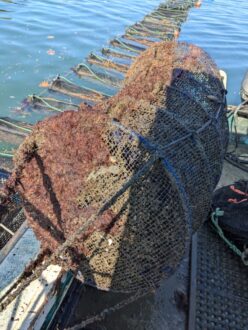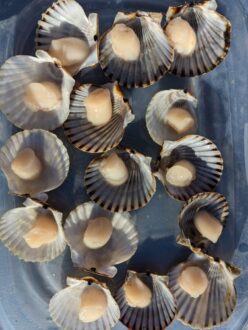A recent Northeast SARE aquaculture project demonstrated how Maine seafarms can farm multiple crops in the same space by raising scallops in lantern nets arranged below oyster cages.
In Northeast SARE Farmer Grant FNE23-052, Growing Bay Scallops on a Maine Oyster Farm as a Strategy to Diversify Crops and Adapt to a Warming Gulf, Winnegance Oyster Farm experimented with growing bay scallops alongside their primary crop, oysters. The project built on local knowledge of scallop farming by focusing on bay scallops, which have been moving north as waters off the coast of Maine warm, over the more traditional sea scallops.
The project also explored a novel approach to mitigating biofouling, the contamination of a farm product by the encroachment of other species. Area farms who had previously experimented with sea scallops noted that one of the biggest challenges with the lantern nets was the accumulation of algaes and pests like gelatinous sea squirt colonies - masses of tiny creatures called zooids that typically attach to rocks and boat hulls. The gelatinous goo the zooids form makes the lantern nets extra heavy, posing a danger to farmers as well as their crop.
To reduce the number of contaminating species in the lantern nets, project leader Jordan Kramer constructed a unique raft system. The raft system allows farmers to rotate the lantern nets while partially submerged, keeping scallops safe underwater while drying pests out above the surface. The final iteration of the net drying raft consisted of a cedar lumber frame holding a wire mesh half cylinder. Two 80 liter oyster cage floats were fastened to the sides for flotation.

Beginning with one millimeter shell-height scallop seeds in mesh bags in lantern nets at a density of 10,000 per bag, the majority of scallops (79%) had reached a marketable size after 15 months of growth.
“Growing bay scallops on my farm was clearly technically feasible- even with the high mortality seen during this project. Seed costs were low and the scallop nursery required only a small investment in farm space,” Kramer said, in the project's final report. “Economically there are still several hurdles to making this a viable large scale crop- including the regulations that prohibit the sale of live scallops and the high labor demands of processing. If these barriers could be removed, bay scallops would be an excellent secondary crop on my farm.”
